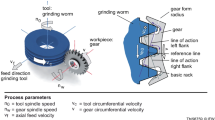Abstract
Grinding of helical flutes is an important step in the process chain of cylindrical tool manufacturing. The grinding process defines the dynamic performance of the manufactured tool. Moreover, the surface quality and flute shape are primarily determined. For this reason, finding optimum process parameters is essential, especially in process planning of individual tools. In the industry, manual experiments are carried out for the machine set up. This leads to high costs due to machine hours, labor and material costs. This paper presents a self-optimizing and adaptable process planning method to reduce costs for process planning and improve the process result. The developed method allows to identify optimum cutting speed and feed with respect to economic efficiency and quality for new tools without additional machining experiments. Geometric-kinematical cutting simulations in combination with empirical models are used to predict the process outcome. The empirical models are derived from machine learning and improved automatically with an increase of process data. Applying the presented method in a case study, the machining time could be reduced by up to 38.1% and the core diameter deviation by up to 73.7%. Moreover, it is shown that the presented methods allow a continuous improvement of the process models.








Similar content being viewed by others
References
Zhou W, Tang J, Chen H et al (2019) Modeling of tooth surface topography in continuous generating grinding based on measured topography of grinding worm. Mech Mach Theory 131:189–203
Brinksmeier E, Aurich JC, Govekar E et al (2006) Advances in modeling and simulation of grinding processes. CIRP Ann 55(2):667–696
Deichmueller M, Denkena B, De Payrebrune KM et al (2010) Determination of static and dynamic deflections in tool grinding using a dexel-based material removal simulation. In: CIRP 2nd international conference process machine interaction, Vancouver
Uhlmann E, Schröer N (2015) Advances in tool grinding and development of end mills for machining of fibre reinforced plastics. Procedia CIRP 35:38–44
Snoeys R, Peters J (1974) The significance of chip thickness in grinding. CIRP Annals 23:227–237
Deichmueller M, Denkena B, De Payrebrune KM (2013) Modeling of process machine interactions in tool grinding. In: Denkena B, Hollmann F (eds) Process machine interactions—prediction and manipulation of interactions between manufacturing processes and machine tool structures. Lecture notes in production engineering. Springer, Berlin, pp 143–176
Weinert K, Blum H, Jansen T et al (2007) Simulation based optimization of the NC-shape grinding process with toroid grinding wheels. Prod Eng Res Devel 1(3):245–252
De Payrebrune KM, Kröger M (2016) An integrated model of tool grinding: challenges, chances and limits of predicting process dynamics. Prod Eng Res Devel 10(4–5):421–432
Weinert K, Mehnen J, Stautner M (2004) The application of multiobjective evolutionary algorithms to the optimized tool paths for multi-axis die and mould making. In: Intelligent computation in manufacturing engineering
Aurich JC, Biermann D, Blum H et al (2009) Modelling and simulation of process: machine interaction in grinding. Prod Eng Res Devel 3(1):111–120
Abele E, Fujara M (2010) Simulation-based twist drill design and geometry optimization. CIRP Ann 59(1):145–150
Pandiyan V, Caesarendra W, Tjahjowidodo T et al (2018) In-process tool condition monitoring in compliant abrasive belt grinding process using support vector machine and genetic algorithm. J Manuf Processes 31:199–213
Arrazola PJ, Özel T, Umbrello D et al (2013) Recent advances in modelling of metal machining processes. CIRP Ann 62(2):695–718
Denkena B, Böß V (2009) Technological NC simulation for grinding and cutting processes using CutS. In: Proceedings of the 12th CIRP conference on modelling of machining operations
Hook TV (1986) Real-time shaded NC milling display. ACM SIGGRAPH Comput Graph 20(4):15–20
Altintas Y, Kersting P, Biermann D et al (2014) Virtual process systems for part machining operations. CIRP Ann 63(2):585–605
Kirkpatrick S, Gelatt CD, Vecchi MP (1983) Optimization by simulated annealing. Science (New York NY) 220:671–680
Acknowledgements
The investigations were conducted within the DFG transfer project BO 3523/6-1 of the priority program 1180. We thank the German Research Foundation for supporting this project.
Author information
Authors and Affiliations
Corresponding author
Additional information
Publisher's Note
Springer Nature remains neutral with regard to jurisdictional claims in published maps and institutional affiliations.
Rights and permissions
About this article
Cite this article
Denkena, B., Dittrich, MA., Böß, V. et al. Self-optimizing process planning for helical flute grinding. Prod. Eng. Res. Devel. 13, 599–606 (2019). https://doi.org/10.1007/s11740-019-00908-0
Received:
Accepted:
Published:
Issue Date:
DOI: https://doi.org/10.1007/s11740-019-00908-0




